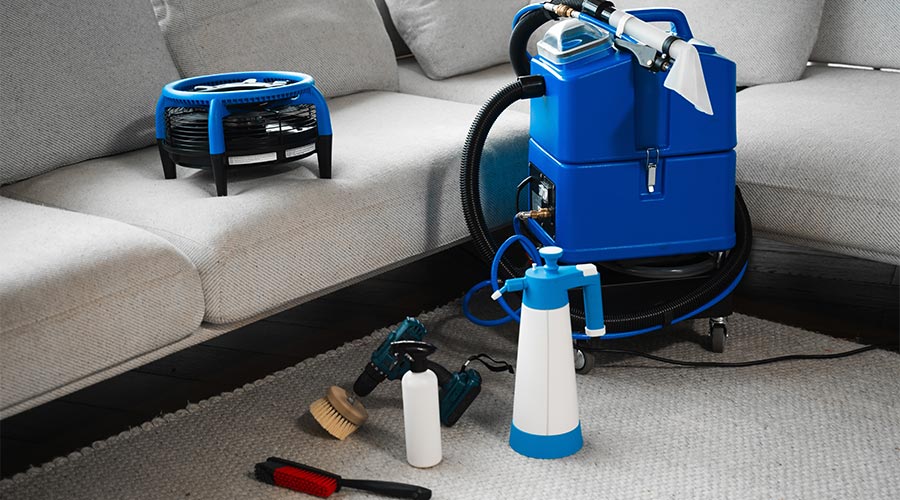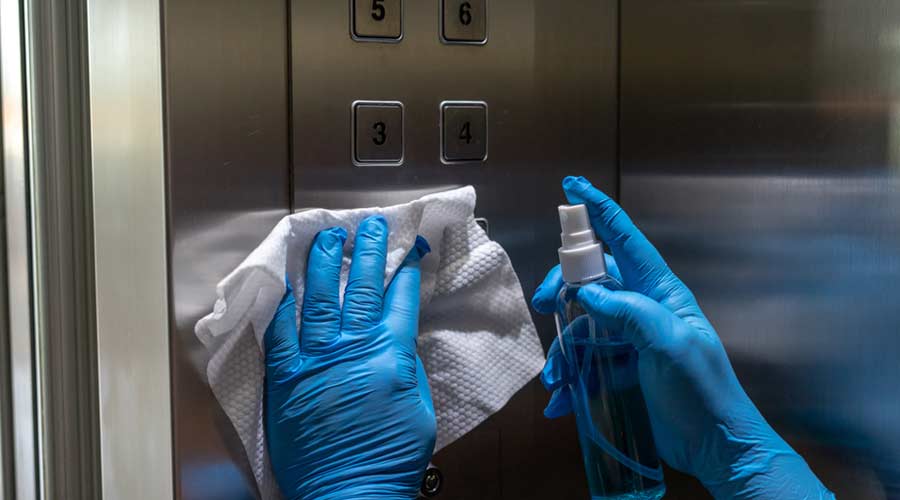
Anyone who watched television in the 1970s and 1980s will remember the classic Ginsu knife advertisements, “It slices, it dices, but wait ... there’s more!” These upselling techniques are a part of the modern memory for a reason — because they worked. If a customer already trusts a jan/san distributor, and has spent money or is planning to make an investment in a floor cleaning machine, why not make it worth their while? Let them know other ways that machines can be used to save them time, money, or grow their business.
The biggest building service contractors (BSCs) and in-house departments are going to spend the necessary money to buy all of the most specialized equipment. They might even have specialized staff whose job it is to take care of those once-in-a-while jobs, like cleaning the upholstery and pressure washing concrete or tile surfaces. For everyone else, they must make do with the tools on hand unless they want to spend a fortune on a task they tackle just once or twice a year. However, there are specialized tools that can make their existing carpet extractors a goldmine of utility.
There are several ways distributors can go about building an arsenal of cleaning tools for their customers. Craig Jasper, an approved instructor of the Institute of Inspection Cleaning and Restoration Certification(IICRC), recommends starting with a good carpet extractor. While hot water extraction machines are intended to be carpet cleaners, they can, with a little outlay, become a veritable Swiss Army Knife of cleaning tools.
He emphasizes that walk-behind models are easy for end users to use and repair. Another benefit of using extraction machines is that all of the dirt, germs, allergens, spores, etc. are being removed while other types of scrubbers simply move them around without necessarily extracting them. That makes hot water extraction machines more hygienic options, especially for customers in healthcare or education settings.
Versatility may be the key to making the machines more useful, but figuring out the hook is still the most important job for sales and distribution.
“The reality is that everyone loves a deal,” says Jasper. “You just have to know what kind of deal they’re looking for.”
For example, most in-house facility managers want to know how a deal is going to save them money, and how it will improve productivity for them and their staff. BSCs, on the other hand, want to know how the equipment is going to make the cleaning process more efficient, creating more profit over time. BSCs want to know how they can provide more services for their current customers and market those services to new customers.
How to Accessorize
For distributor sales representatives, selling the equipment is just the first goal. A close second is upselling with parts and accessories — it’s the “wait, there’s more!” part of the sale.
The sight of a travel mug or other types of drink is increasingly common these days. This means an increase in spills. Consequently, cleaning the furniture is no longer just an occasional task. With the correct attachments/hand tools, carpet extractors can quickly and easily be turned into upholstery cleaners used to tackle any number of stains. This is a great selling point for both BSCs and in-house janitorial teams.
Add in the right cleaning solutions/chemicals and this equipment can become even more specialized. For instance, there are specialized solutions that can break down the enzymes that cause urine odors commonly associated with nursing homes. Using those and the hand tools to clean resident mattresses can create a much more appealing and sanitary living space for residents and visitors alike.
Childcare facilities and gyms can also use these tools to clean mats and other soft materials of sweat and other bodily fluids, wicking away these impurities in ways that other scrubbers wouldn’t.
Another accessory that easily modifies a carpet extractor to solve bigger problems is a pressure wand. The traditional uses of high-pressure washing are all still on the table. Adding these attachments to an extractor will allow end users to clean concrete, siding, and other hard surfaces, easily getting rid of dirt and mildew, without the expense of a second pressure-washing machine.
With the right cleaning solutions and training, as well as an adjustment in pressure, these attachments can tackle even more projects plaguing cleaning teams. This provides yet another opportunity for distributors to upsell on equipment.
For example, commercial kitchens are a great place to use high-pressure wands, as long as they’re used correctly. Pressure is a great way to remove grease and grime that can build up and create dangerous working conditions. Using it to clean exhaust systems, ducts, and hoods also helps prevent fire hazards.
Using pressure washers in restrooms can also provide a touch-free way to sanitize surfaces in situations where there might be contaminants. They can also be used to clean and sanitize play structures in childcare facilities or equipment in gyms and athletic facilities.
But wait, there’s even more. With so many facilities being impacted by extreme weather, distributors would be remis not to include attachments and hand tools that aid in extraction.
Most businesses are going to call professional flood mitigation services for large-scale floods, but when something small-scale hits, it’s got to be taken care of internally. Any facility of decent size will likely experience water issues at some point. Whether it’s a severe storm, or a simple sink overflow, broken pipe, air conditioning malfunction, it’s a mess that needs to be cleaned up fast. Distributors should stress to customers that having emergency mitigation tools like a flood extraction wand and anti-mildew solutions on hand, and having staff trained in how to use them, is essential to quick cleanup.
Fighting back against flooding requires a powerful seal and the ability to compress carpet as much as possible to suck out water with each pass of the wand. Distributors should supply customers with a wand that also reduces back strain. A good wand that attaches to their existing equipment can make a bad day easier.
In the end, customers are going to pick and choose the equipment and accessories they need, so what it really comes down to are the chemical solutions.
“It’s just a juice dispenser,” Jasper says. “Distributors are going to make their money from customers coming back to buy more juice.”
Those repeat purchases have become easier for end user customers thanks to advancements in e-commerce. Now customers can just go online and click a button to get what they want. But that convenience comes at a cost — purchasing is easier, but it’s harder for businesses to connect with the expertise they need.
“Providing training is one thing that will set distributors apart from the internet,” Jasper says. “Otherwise, you’re just a commodity and a price.”
Daniel Josephs, executive vice president and chief operating officer at Spruce Industries, Rahway, New Jersey, agrees with Casper’s assessment.
“All distributors have access to the same equipment and chemicals and accessories to sell for this space, but very few know what they are doing,” says Josephs.
Providing on-site training, subscriptions to training videos, and clear, easy-to-understand documentation to go along with the equipment, accessories, and chemical solutions, will build customer loyalty. This is one way to enhance the juice bar and keep customers coming back for more than just a quick click–and-order.
“Carpet care and fabric care are black boxes for distributors,” says Josephs. “Very few do it well and know how to teach the end user how to do it well. Those that can do it well excel at it and can make a lot of money. The rest of us just take orders and hope we don’t screw up the customers carpets or upholstery, to put it bluntly.”
Caryn Jones is a freelance writer based in Centennial, Colorado.

 The Down and Dirty on Cleaning in Virus Season
The Down and Dirty on Cleaning in Virus Season How Surfactant Use is Expanding in Commercial Cleaning
How Surfactant Use is Expanding in Commercial Cleaning